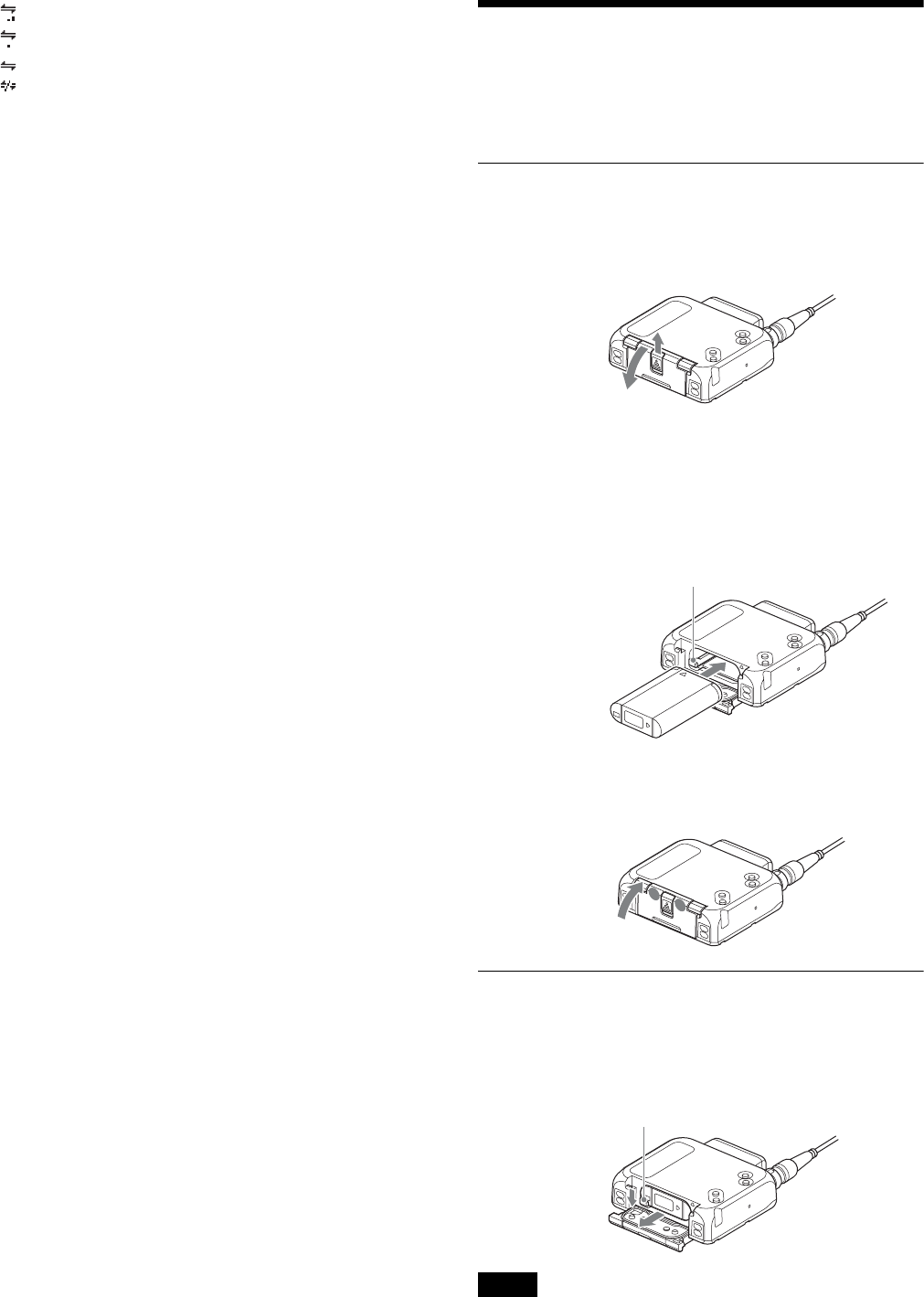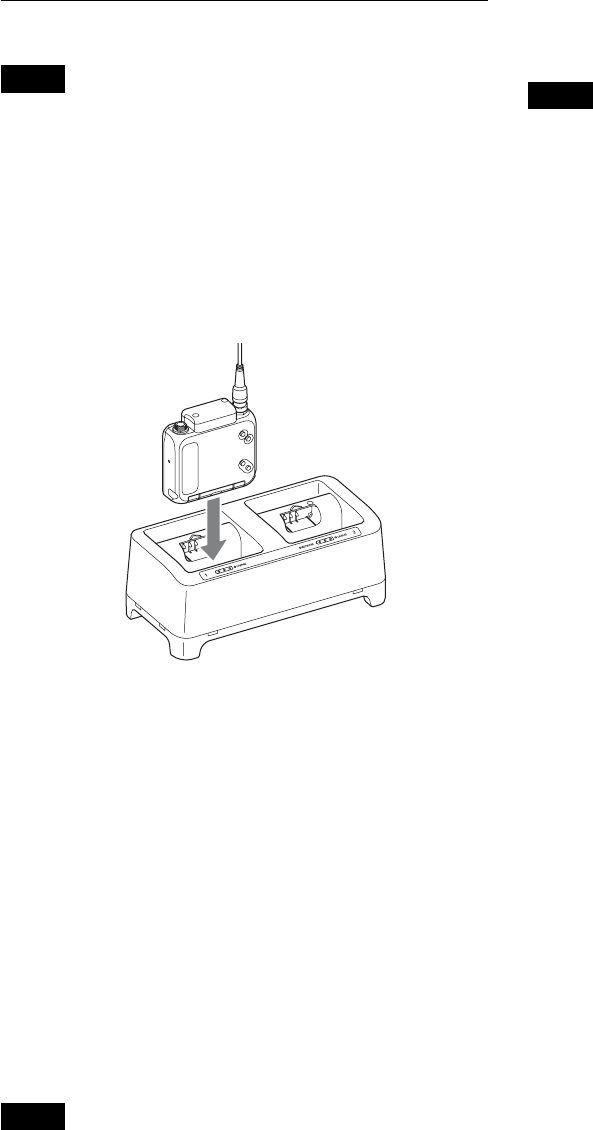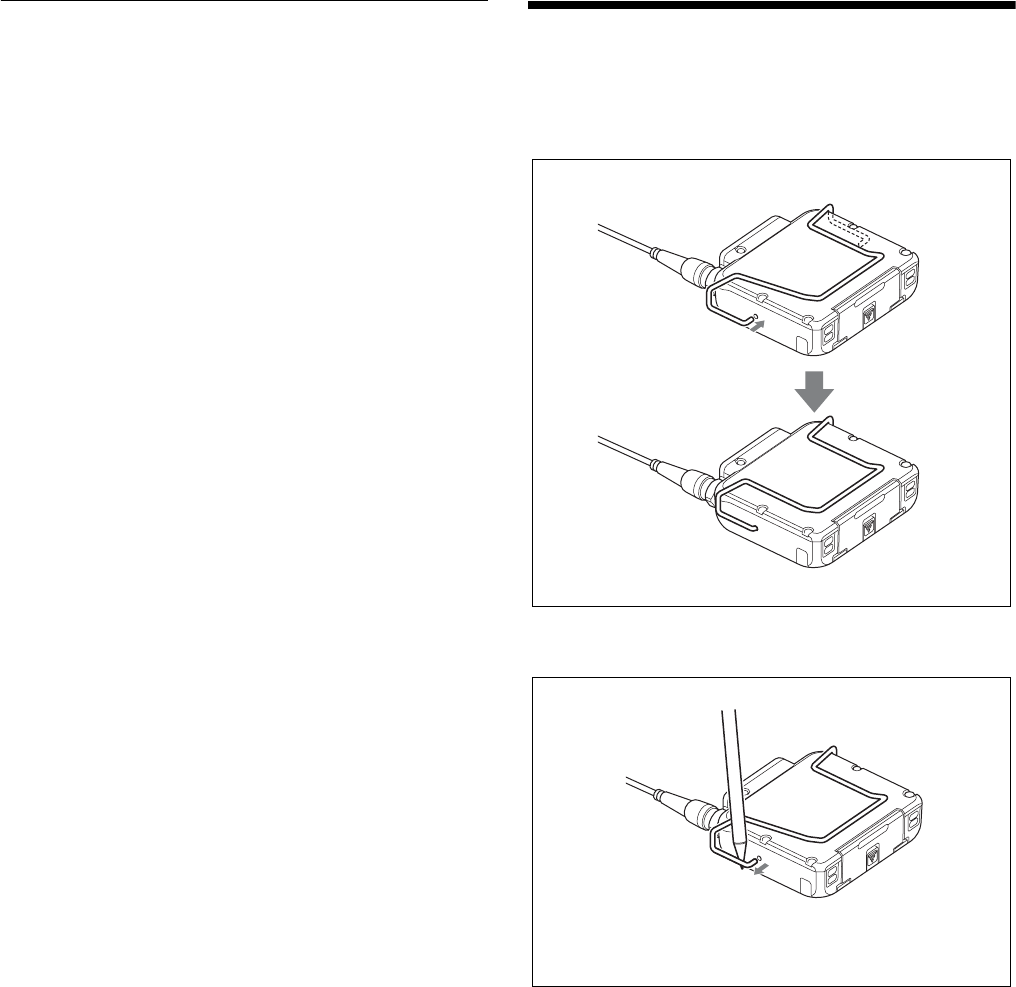Sony Group DWTB03R DIGITAL WIRELESS TRANSMITTER User Manual DWT B03R
Sony Corporation DIGITAL WIRELESS TRANSMITTER DWT B03R
Contents
- 1. 05 User Manual
- 2. 05 User Manual_Notice
05 User Manual

Digital Wireless
Transmitter
Operating Instructions
DWT-B03R
4-739-796-01 (1)
© 2018 Sony Corporation

2
Table of Contents
Features ...................................................................... 3
Parts Identification ................................................... 4
Power Supply ............................................................. 5
Inserting the Battery .............................................. 5
Removing the Battery ............................................ 5
Charging the Battery .............................................. 6
Setting the Transmission Channel ........................... 7
Selecting the Frequency Band, Group, and
Channel ................................................................ 7
Using Cross Remote .................................................. 8
Pairing .................................................................... 8
Using the Encrypted Transmission Function ......... 9
Using the Encryption Key Modes (SECURE
KEY / AES256) ................................................... 9
Using the Password Mode (PASSWORD) .......... 10
Basic Menu Operations .......................................... 10
Menu Settings .......................................................... 11
Unit Name Setting (NAME) ................................ 11
Frequency Band Selection (BAND) .................... 11
Group Selection (GROUP) .................................. 12
Channel Selection (CH) ....................................... 12
Audio Attenuator Setting
(AF ATT) ........................................................... 12
Low-Cut Filter Setting (LCF) .............................. 12
Lock Function (LOCK) ....................................... 12
Power Save Setting (POWER SAVE) ................. 13
Cross Remote (RF REMOTE) ............................. 13
Receiver Search Function (SEARCH RX) .......... 13
Audio Codec Mode Setting (CODEC MODE) ... 13
Encrypted Transmission Function Setting
(ENCRYPTION) ............................................... 13
Audio Input Level Setting
(INPUT LEVEL) ............................................... 13
Audio Phase Switch Function (AF PHASE) ....... 14
Internal Signal Generator Function (INTERNAL
SG) ..................................................................... 14
Transmission Power Setting (RF POWER) ......... 14
Maximum Transmission Power Setting (MAX RF
POWER) ............................................................ 14
Total Usage Time Display (TIME) ...................... 14
Remaining Battery Indicator Setting (BATTERY
REMAIN) .......................................................... 14
Display Brightness Setting (BRIGHTNESS) ...... 15
Automatic Display Dimmer Setting (DISPLAY
DIMMER) .......................................................... 15
LED Brightness Setting (LED DIMMER) .......... 15
Settings Storage Function (USER MEMORY) ... 15
Factory Settings Restoration (FACTORY
PRESET) ........................................................... 15
Software Version Display (VERSION) ............... 16
Attaching the Belt Clip ........................................... 16
Block Diagram ......................................................... 17
Troubleshooting ....................................................... 18
Important Notes on Operation .............................. 20
Operation and Storage ......................................... 20
Cleaning ............................................................... 20
Notes on Simultaneous Multi-Channel
Operation ........................................................... 20
Notes on Use with Microphones .......................... 20
CROSS REMOTE Compatibility ........................ 20
Notes on Accessories ........................................... 21
Notes on the Battery ............................................ 21
Notes on Drip Resistance ..................................... 21
Specifications ........................................................... 22
Main Unit ............................................................. 22
NP-BX1 Rechargeable Battery Pack ................... 22
Carrier Frequencies and Channel Steps ............... 24

3
Features
The DWT-B03R is a drip-resistant digital wireless
transmitter featuring a highly durable yet compact and
lightweight design. The unit is suitable for broadcast and
ENG (electronic news-gathering) applications, as well as
for musical and television video production.
What is DWX?
DWX refers to Sony’s new digital wireless microphone
system. The DWX series reflects Sony’s extensive
expertise in professional microphones and sound design. It
represents a successful blend of Sony know-how, wireless
technology renowned for stability, and cutting-edge digital
audio technology.
In addition to realizing the high sound quality possible
with a digital system, the DWX series supports multi-
channel simultaneous operation, encrypted transmission,
and metadata transmission for monitoring the status of
multiple transmitters. Using a main link and a separate
additional link, remote control of transmitters from the
receiver is also possible. With its many advanced features,
the system has the potential to revolutionize the workflow
of professional applications.
What is WiDIF-HP?
WiDIF-HP (WiDIF: Wireless Digital Interface Format,
HP: High Profile) is a wireless digital audio interface
format developed by Sony.
It enables highly secure transmission with high sound
quality and low system latency, and supports simultaneous
multi-channel operation.
What is Cross Remote?
Cross Remote is a system that allows transmitters to be
monitored and controlled from a receiver and the Wireless
Studio control software installed on a computer connected
to the receiver.
For example, the settings of a transmitter worn under
clothing can be easily changed over the wireless link.
Compact and lightweight design
The unit is equipped with a magnesium-alloy casing,
providing a body that is durable in addition to being
compact and lightweight.
High sound quality and low latency
Low system latency of 1.2 ms is achieved when using
codec MODE2.
Switch between four audio codec modes based on your
operational needs.
For details, see “Audio Codec Mode Setting (CODEC
MODE)” (page 13).
High drip resistance against sweat, rain,
and sprays
The inside of the unit’s casing includes packing, and the
unit’s connectors are drip resistant. These features provide
the unit with a drip resistance equivalent to IPX4/IPX5
(according to Sony test conditions).
Lithium-ion battery for extended use
The NP-BX1 rechargeable battery pack (supplied) allows
extended operation times of up to about 7 hours.
Simultaneous multi-channel operation
Simultaneous multi-channel operation is made possible
with the 375-kHz interval channel plan.
Encrypted transmissions
AES 256-bit encryption allows for highly secure wireless
transmissions.
Support for a wide range of audio input
levels
For details, see “Audio Input Level Setting (INPUT
LEVEL)” (page 13).
Switchable RF output power
For details, see “Transmission Power Setting (RF
POWER)” (page 14) and “Maximum Transmission Power
Setting (MAX RF POWER)” (page 14).
Digital low-cut filter
For details, see “Low-Cut Filter Setting (LCF)”
(page 12).
Audio phase switch function
For details, see “Audio Phase Switch Function (AF
PHASE)” (page 14).
Power sleep mode
For details, see “Power Save Setting (POWER SAVE)”
(page 13).
User settings function
For details, see “Settings Storage Function (USER
MEMORY)” (page 15).
Organic EL (electroluminescent) display
The quick response of the OLED (organic light-emitting
diode) display enables real-time operating conditions to be
displayed clearly and accurately.

4
Parts Identification
aAudio input connector (mini 3-pin with lock)
Connects to a lavalier microphone.
Connecting the microphone
bAntenna
cPOWER button
Turns the unit on or off.
Hold down the button for 1 second or longer to turn the
unit on. To turn the unit off, hold down the button until the
POWER indicator turns off.
dSET button
Allows you to adjust the displayed function settings and
apply the adjusted values.
Holding down the SET button while turning the unit on
turns the unit on without sending a signal.
e+ and – buttons
Selects the functions or values shown on the display.
Holding down the – button while turning the unit on
activates the pairing operation for the wireless remote
control function.
fBattery charger connector
Connects to the BC-DWX1 battery charger (not supplied),
and allows you to charge the lithium-ion battery inserted in
the unit.
gBattery compartment cover
Insert the NP-BX1 rechargeable battery pack (supplied)
here.
For safety, use only the Sony battery packs and AC
adaptors listed below.
•NP-BX1
For details on how to insert batteries, see “Power Supply”
(page 5).
hDisplay
ARF transmission indicator
Indicates the current transmission status.
BRF transmission power indicator
Indicates the current transmission power setting. You can
change the setting with the RF transmission power setting
function.
H: Transmitting at 25 mW.
M: Transmitting at 10 mW.
L: Transmitting at 2 mW.
CLock indicator
Indicates whether the accidental operation locks are
enabled. Nothing is displayed when the lock function is
disabled.
: Operation of the POWER button is locked.
: Changes to the settings are locked.
: Operation of the POWER button and changes to the
settings are locked.
For details, see “Lock Function (LOCK)” (page 12).
DCross Remote condition indicator
Indicates the signal transmission condition of the wireless
remote control function (4 levels).
1: GND
2: +5.2 V (output)
3: Hot +5.2 V
Microphone
To secure the connection, turn the ring on the
connection plug to lock it.
: Currently transmitting.
– : RF transmission stopped.
: Good transmission.
NAME
DWT-B03R

5
When the wireless remote control function is disabled, this
indicator does not appear.
ERemaining battery indicator
Indicates the remaining battery charge.
For details, see “Remaining battery indicator” (page 6).
FMenu display area
Displays the status of the various functions. To cycle
through the functions, press the + and – buttons.
For details, see “Menu Settings” (page 11).
iAF (audio input level) / PEAK indicator
Lights green when the audio signal input is stronger than
the reference level.
Lights red as a warning of excessive input when the audio
signal input is 3 dB below the level at which distortion
begins.
jPOWER indicator
Lights green when the unit is turned on. This blinks when
the battery charge is low.
Power Supply
The unit can operate on the lithium-ion battery
continuously for about 7 hours at 25 °C (77 °F).
Inserting the Battery
1
Slide the tab at the center of the unit’s bottom, and pull
the battery compartment cover outward to open it.
2
Insert the lithium-ion battery while holding down the
lock lever with the battery’s edge until the battery is
fully inserted and locked into place.
Be sure to check that the lithium-ion battery is oriented
correctly beforehand.
3
Press both sides of the tab at the bottom of the unit to
close the battery compartment cover.
Removing the Battery
Open the battery compartment cover, and shift the lock
lever to remove the battery.
Be careful not to drop the battery.
• To prevent dirtying of the terminals, short circuits, or
other problems, place the removed battery in a plastic
: Somewhat good transmission.
: Somewhat poor transmission.
: Poor transmission.
: Unable to communicate with paired receiver.
Notes
Lock lever
Lock lever

6
bag, for example, and keep it away from metal objects
during transport or storage.
• The battery will slowly discharge, even when the unit is
turned off. Remove the battery from the unit before
extended periods of disuse.
Charging the Battery
• Be sure to charge the battery before using the unit for the
first time.
• A charged battery will slowly discharge, even when it is
not in use. Be sure to charge the battery before each use
to ensure safe operation.
Use the BC-DWX1 battery charger to charge the battery
while it is inserted in the unit.
Insert the unit fully into the charging port on the BC-
DWX1.
For details on charging, refer to the BC-DWX1 battery
charger’s operating instructions.
Charging time
Fully charging a fully discharged NP-BX1 rechargeable
battery pack (supplied) inserted in the unit in an ambient
temperature of 25 °C (77 °F) will take about 3 hours.
The charging time may be longer depending on your
operating environment. In addition, battery packs that have
not been used for extended periods may take longer to
charge.
When you are in a hurry
If necessary, devices can be removed from the unit before
they are fully charged. However, their usable durations
will vary depending on how long they were charged.
• If you insert the unit into the BC-DWX1 while the unit
is turned on, the unit will turn off, but charging will still
occur. The unit will remain turned off, even after you
remove it from the BC-DWX1.
• Proper charging may not be possible if the battery
terminals or the unit’s charging terminals are dirty. In
such cases, wipe the terminals with a dry cloth or cotton
swab. When doing so, make sure that the unit is turned
off, and never touch the terminals directly with your
hands.
• Always use genuine Sony lithium-ion batteries.
Remaining battery indicator
Indicates the remaining battery charge.
Replace the battery with a charged battery when the
remaining battery indicator starts to blink.
• If you intend to use the unit continuously for an extended
period, we recommend replacing the battery with a fully
charged battery.
• The indicator may not be correct depending on your
operating environment.
• The unit is designed to operate for at least 30 minutes
after the remaining battery indicator starts to blink, but it
may operate for longer in optimal environments.
Notes
Notes
Notes

7
Setting the Transmission
Channel
The unit provides groups of interference-free channels.
When using multiple wireless microphones and
transmitters at the same time (simultaneous multi-channel
operations) within the same area, you must use channels
within the same group to prevent signal interference.
To set the transmission channel on the unit, first select the
frequency band, group, and channel on the receiver using
its RF indicator and scanning functions, then match the
frequency band, group, and channel settings on the unit
with the settings on the receiver.
• Certain transmission channels cannot be used with the
wireless remote control function.
For details on transmission channels that support the
wireless remote control function, refer to “Sony Digital
Wireless Microphone System Frequency Lists” on the
supplied CD-ROM.
• When selecting the channel, “(INCOMPATIBLE WITH
RF REMOTE)” will slide across the display for
transmission channels that cannot be used with the
wireless remote control function.
• When a transmission channel that cannot be used with
the wireless remote control function is selected,
“RESTRICTED BY GP/CH SETTING” appears on the
RF REMOTE screen and the wireless remote control
function cannot be used. To enable use of the wireless
remote control function, select transmission channels for
which “(INCOMPATIBLE WITH RF REMOTE)” does
not appear during channel selection.
Selecting the Frequency Band,
Group, and Channel
Set the frequency band (BAND), group (GROUP), and
channel (CH) as follows.
For details on groups and channels, refer to “Sony Digital
Wireless Microphone System Frequency Lists” on the
supplied CD-ROM.
For details on menu operations, see “Basic Menu
Operations” (page 10).
These settings cannot be changed during actual signal
transmission.
1
Turn the unit off, and then hold down the POWER
button while pressing the SET button.
The unit turns on with signal transmission stopped.
2
Use the + and – buttons to display the BAND screen.
3
Hold down the SET button until the setting value
blinks.
4
Use the + and – buttons to select the frequency band.
5
Press the SET button to confirm.
6
Use the + and – buttons to display the GROUP screen.
7
Hold down the SET button until the setting value
blinks.
8
Use the + and – buttons to select the group.
9
Press the SET button to confirm.
10
Use the + and – buttons to display the CH screen.
11
Hold down the SET button until the setting value
blinks.
12
Use the + and – buttons to select the channel.
13
Press the SET button to confirm.
To start signal transmission with the selected frequency
band, group, and channel, turn off the unit and then turn it
on again.
Configuring the settings via Cross Remote
pairing
When the unit is paired with the receiver, the unit’s
transmission channel is automatically set to the receiving
channel on the receiver.
For details on pairing, see “Pairing” (page 8).
Notes
Notes
Notes

8
Using Cross Remote
The unit is equipped with a wireless remote control
function that allows the unit’s settings (low-cut filter,
attenuation controls, power controls, etc.) to be controlled
from the receiver or other devices. This makes it easier to
operate and manage the microphone system while in the
field.
The IEEE802.15.4-compliant wireless remote control
function uses the 2.4- GHz band and has no effect on the
RF band of digital wireless audio.
The function is activated when the unit is paired with the
receiver via the RF REMOTE function.
Pairing must be performed before the wireless remote
control function can be used.
If “RESTRICTED BY GP/CH SETTING” appears on the
RF REMOTE screen, the wireless remote control function
cannot be used. To enable use of the wireless remote
control function, select a different transmission channel.
For details on changing the transmission channel, see
“Setting the Transmission Channel” (page 7).
Pairing
Pairing links the unit to the receiver that will control the
unit via the wireless remote control function.
Pairing will start automatically if pairing mode is enabled
on the receiver side and you turn on the unit by holding
down the POWER button while pressing the – button on
the unit.
To perform pairing manually via the settings menu,
perform the following.
1
Enable paring mode on the receiver that will be
controlling the unit.
For details, refer to the receiver’s operating
instructions.
2
Use the + and – buttons to display the RF REMOTE
screen.
3
Hold down the SET button until the setting value
blinks.
4
Use the + and – buttons to select PAIRING.
5
Press the SET button to confirm.
The unit sends a pairing request to the receiver on
which pairing mode is enabled.
If you press any button on the unit before pairing is
complete, pairing mode will be canceled.
When communication with the receiver is established,
the condition indicator ( ) rises, indicating that the
RF REMOTE function is enabled and remote control
is possible.
Using Cross Remote with a previous
pairing setting
Set the RF REMOTE screen setting value to ON.
• When RF REMOTE is set to ON, communication will be
established with the previously paired receiver. To use
the wireless remote control function with a different
receiver, perform the pairing procedure again with the
target receiver.
• Multiple instances of the unit cannot be paired with the
same receiver.
• Resetting the unit to factory settings using the
FACTORY PRESET function (page 15) clears any
pairing with a receiver.
Unit operations that can be performed via remote
control
• Unit name setting
• Frequency band, group, and channel selection
• RF transmission power setting
• MIC/LINE setting and attenuator setting for the audio
input level
• Low-cut filter setting
• Power save setting
• Total usage time reset
• Audio codec mode setting
• Internal signal setting
• Lock setting
• Remaining battery indicator setting
For details on the settings, see “Menu Settings” (page 11).
To perform remote control, the receiver must be equipped
with a control function for the target setting for control.
For details, refer to the receiver’s operating instructions.
Stopping Cross Remote
Set the RF REMOTE screen setting value to OFF.
Notes on Cross Remote
As the unit’s wireless remote control function uses the 2.4-
GHz band, it may be subject to interference from other
devices.
• If pairing fails (i.e., “Pairing fail” is displayed), perform
pairing again.
In such cases, communication between the transmitter
and receiver may not have been established within the
predetermined amount of time.
Pairing may be hindered if another receiver is engaged in
pairing nearby.
• Unstable remote control may be resolved by disabling
and reenabling the wireless remote control function in
the RF REMOTE screen, then reestablishing connection
with the transmitter (i.e., changing to a channel with less
interference).
Notes
Notes

9
Finding the unit from a paired receiver
Some receivers are equipped with a function that finds the
transmitters with which they are paired.
When this search function is used on a receiver that is
paired with the unit, the unit’s organic EL display will
blink.
If communication with the paired receiver is currently not
possible, the unit’s organic EL display will not blink when
the receiver’s search function is used.
For details, refer to the receiver’s operating instructions.
Using the Encrypted
Transmission Function
The unit is capable of transmitting encrypted signals to
prevent unwanted surveillance.
To use the function, select one of the following encryption
modes.
Encryption key modes (SECURE KEY / AES256):
An encryption key is automatically generated by the
transmitter and used by both the transmitter and receiver in
these one-to-one encrypted transmission modes.
The SECURE KEY mode is compatible with first and
second generation DWX-series devices.
The AES256 mode uses AES 256-bit encryption for a
higher level of security in transmissions.
Password mode (PASSWORD): A user-created
password of up to 8 characters can be set for multiple
transmitters (this unit) and receivers in this mode. This
allows encrypted transmission within a group.
Make sure that encryption mode settings are identical on
both the transmitter (this unit) and the receiver.
Using the Encryption Key Modes
(SECURE KEY / AES256)
Use these modes for one-to-one encrypted transmission
between one transmitter (this unit) and one receiver.
To enable encrypted transmission in these modes, an
encryption key that cannot be read from the outside is
automatically generated by the unit, and the key is
transmitted to the receiver via the wireless remote control
function.
A new encryption key for the transmitter (this unit) and
receiver is automatically generated for each key
transmission, resulting in highly secure communication.
The encryption key for the transmitter (this unit) and
receiver is retained when the unit is turned off, allowing
you to resume the same encrypted transmission the next
time you turn the unit on.
1
Prepare the transmitter (this unit).
1Hold down the SET button in the unit’s
ENCRYPTION screen until the setting value
blinks.
2Use the + and – buttons to select SECURE KEY or
AES256, and press the SET button.
2
Prepare the receiver.
Set the receiver that will receive the encryption key to
SECURE KEY or AES256.
For details on receiver operations, refer to the
receiver’s operating instructions.
3
Exchange the encryption key.
Notes
Notes

10
On the receiver side, select REMOTE (wireless
remote) as the encryption key exchange method, and
perform encryption key exchange.
REMOTE cannot be selected when the wireless
remote control function is disabled.
If the receiver does not support AES256 mode, select
SECURE KEY.
For details, refer to the receiver’s operating
instructions.
The unit searches for the receiver with which it is
paired.
When the receiver is found, the encryption key is
exchanged, and encrypted transmission begins.
Using the Password Mode (PASSWORD)
Use this mode for encrypted transmissions between
multiple paired transmitters (this unit) and receivers.
When the same user-created password is set on both the
transmitters (this unit) and the receivers, the audio signal
can be decoded. This mode is useful when you want to
operate multiple transmitters (this unit) and receivers as a
group, or receive transmissions from a single transmitter
(this unit) on multiple receivers at the same time.
1
Hold down the SET button in the unit’s
ENCRYPTION screen until the setting value blinks.
2
Use the + and – buttons to select PASSWORD, and
press the SET button.
3
Enter a password of up to 8 characters on the unit.
For details on how to enter the password, see the
procedure described in “Unit Name Setting (NAME)”
(page 11).
4
Set the encrypted transmission setting on the receiver
to PASSWORD.
5
Set the same password that you set for the unit on the
receiver.
For details on receiver operations, refer to the
receiver’s operating instructions.
We recommend changing the password periodically.
Basic Menu Operations
1
Use the + and – buttons to display screen of the item
you want to set.
Holding down the + and – buttons allows you to cycle
through screens quickly.
In addition, holding down the + button while the first
setting item of the menu is displayed allows you to
jump to the last setting item, while holding down the –
button while the last setting item of the menu is
displayed allows you to jump to the first setting item.
2
Hold down the SET button until the setting value
blinks.
3
Use the + and – buttons to change the setting value.
4
Press the SET button to confirm.
Setting items in the menu
• NAME (transmitter name) setting
• BAND (frequency band) selection
• GROUP selection
• CH (channel) selection
• AF ATT (audio attenuator level) setting
• LCF (low-cut filter) setting
• LOCK function
• POWER SAVE setting
• RF REMOTE (wireless remote control) function
• SEARCH RX (receiver search) function
• CODEC MODE (audio codec mode) setting
• ENCRYPTION (encrypted transmission function)
setting
• INPUT LEVEL (audio input level) setting
• AF PHASE (audio phase switch) setting
• INTERNAL SG (internal signal generator) function
• RF POWER (RF transmission power) setting
• MAX RF POWER (maximum RF transmission power)
setting
•TIME display
• BATTERY REMAIN (remaining battery indicator)
setting
• BRIGHTNESS (display brightness) setting
• DISPLAY DIMMER (automatic display dimmer)
setting
• LED DIMMER (LED brightness) setting
• USER MEMORY (settings storage) function
Notes
Notes
Setting item
Setting value

11
• FACTORY PRESET (factory settings) function
• VERSION (software version) display Menu Settings
This section describes the various setting items and their
values. Underlined values represent factory settings.
Unit Name Setting (NAME)
Specify up to 16 characters for the unit’s name. The
factory setting is the unit’s model name and serial number.
The unit’s name is sent to the receiver as metadata and
used by the receiver to distinguish between different
transmitters.
+ button: Displays the character set. Next, use the + and
– buttons to select a character, and then press the SET
button to add the selected character at the last position of
the current name.
– button: Deletes the last character in the current name.
SET button: Confirms the selected character.
When you are finished editing the name, press the SET
button to confirm it.
You cannot insert or delete characters in the middle of the
name.
The name setting can be changed from the receiver and
other devices via the wireless remote control function.
For details, see “Using Cross Remote” (page 8).
Frequency Band Selection (BAND)
Match the frequency band of the unit with that of the
wireless receiver that will be used with the unit.
The frequency bands that can be set will differ depending
on the models of the unit and the receiver. For details, see
“Carrier Frequencies and Channel Steps” (page 24).
For details on the frequency range of each band, refer to
“Sony Digital Wireless Microphone System Frequency
Lists” on the supplied CD-ROM.
The frequency band setting can be changed from the
receiver and other devices via the wireless remote control
function.
For details, see “Using Cross Remote” (page 8).
• This setting cannot be changed during actual signal
transmission. Turn the unit off, and then hold down the
POWER button while pressing the SET button to turn
the unit on in a state where signals are not transmitted
before changing the setting.
Notes
Notes

12
• After selecting the frequency band, select the group and
channel. To start signal transmission with the selected
frequency band, group, and channel, turn off the unit and
then turn it on again.
Group Selection (GROUP)
See “Carrier Frequencies and Channel Steps” (page 24)
for the factory settings.
For details, see “Selecting the Frequency Band, Group,
and Channel” (page 7).
The group setting can be changed from the receiver and
other devices via the wireless remote control function.
For details, see “Using Cross Remote” (page 8).
Channel Selection (CH)
See “Carrier Frequencies and Channel Steps” (page 24)
for the factory settings.
For details, see “Selecting the Frequency Band, Group,
and Channel” (page 7).
The channel setting can be changed from the receiver and
other devices via the wireless remote control function.
For details, see “Using Cross Remote” (page 8).
Audio Attenuator Setting
(AF ATT)
When INPUT LEVEL is set to MIC, select the attenuator
level for audio inputs.
This setting cannot be changed when INPUT LEVEL is set
to LINE.
Input audio from the connected microphone, and use the +
and – buttons to select the attenuator level while viewing
the input level meter.
The reference levels for the various settings are as follows.
The audio attenuator setting can be changed from the
receiver and other devices via the wireless remote control
function.
For details, see “Using Cross Remote” (page 8).
Low-Cut Filter Setting (LCF)
Select from the following frequencies for the low-cut
filter.
OFF: Disables the low-cut filter.
20 30 40 50 60 70 80 90
100 120 140 160 180 200 220 (Hz):
Enables the low-cut filter according to the selected
frequency.
The low-cut filter setting can be changed from the receiver
and other devices via the wireless remote control function.
For details, see “Using Cross Remote” (page 8).
Lock Function (LOCK)
Lock and prevent operations such as those for the POWER
button and for settings changes. This prevents you from
accidentally turning the unit off, for example.
UNLOCK: Disables operation locks for the POWER
button and settings changes.
POWER: Locks POWER button operations only.
SETTING: Locks setting change operations only.
PWR+SET: Locks both POWER button and settings
change operations.
Disabling the lock function
Set LOCK to UNLOCK.
Changes to the LOCK function are enabled, even when
settings change operations are locked.
Lock function shortcuts
You can use to the unit’s buttons to enable or disable the
PWR+SET setting and all lock functions without
displaying the settings menu.
To enable the PWR+SET setting, hold down the SET and
+ buttons at the same time until the PWR+SET icon
appears.
To disable the lock, hold down the SET and – buttons at the
same time until the lock indicator disappears.
The lock setting can be changed from the receiver and
other devices via the wireless remote control function.
For details, see “Using Cross Remote” (page 8).
Changes to settings via the wireless remote control
function are enabled, even when settings change
operations are locked. However, changes to settings will
Notes
Input Attenuation
(dB)
Reference
input level
(dBu)
Maximum
input level
(dBu)
Headroom
(dB)
MIC 0 –58 –22 36
3 –55 –19
6 –52 –16
9 –49 –13
3 dB steps 3 dB steps 3 dB steps
45 –13 +23
48 –10 +24 34
LINE –+4+2420
Notes

13
not be possible via the wireless remote control function on
receivers that do not support the settings change lock
function.
For details, refer to the receiver’s operating instructions.
Power Save Setting (POWER SAVE)
Set the transmitter’s power supply to sleep mode via the
wireless remote control function to conserve power.
ACTIVE: Sets the unit top normal operation mode.
SLEEP: Sets the unit to sleep mode. During sleep mode,
the POWER indicator blinks at 2-second intervals.
Returning to normal operation mode
Press any of the unit’s buttons during sleep mode.
Sleep mode can be exited from the receiver and other
devices via the wireless remote control function.
For details, see “Using Cross Remote” (page 8).
If you turn the unit off with POWER SAVE to SLEEP, the
setting will automatically revert to ACTIVE (normal
operation) the next time you turn the unit on.
Cross Remote (RF REMOTE)
Enable use of the wireless remote control function between
the unit and the receiver that will be used with the unit.
OFF: Disables the wireless remote control function.
ON: Enables use of the wireless remote control function
with the paired device.
PAIRING: Executes a new pairing.
For details, see “Pairing” (page 8).
Receiver Search Function (SEARCH RX)
Use this function to quickly locate a receiver
communicating on the same frequency as the unit.
When the receiver is found, the receiver will react (e.g., the
receiver’s display will blink).
If a receiver does not support the receiver search function,
it will not react.
For details on receiver actions, refer to the receiver’s
operating instructions.
Searching for receivers
Hold down the SET button in the SEARCH RX screen,
and press the SET button again while the “SEARCH?
YES” display is blinking.
Audio Codec Mode Setting (CODEC
MODE)
MODE1: Audio codec mode that is compatible with first
generation DWX-series devices.
MODE2: Audio codec mode that prioritizes short delay
times while maintaining transmission stability and high
audio quality.
MODE3: Audio codec mode that uses additional signal
processing to suppress noise caused by unexpected pulse
interference.
MODE4: Audio codec mode that prioritizes high audio
quality that faithfully reproduces original sounds while
maintaining transmission stability and low latency.
Under normal circumstances, we recommend using
MODE2 (prioritizing delay times) or MODE4 (prioritizing
audio quality).
However, use MODE1 when when using the unit in
conjunction with first generation DWX-series devices, and
use MODE3 in environments where unexpected pulse
interference may occur.
The audio delay durations that occur when transmitting
and receiving with each mode will vary depending on the
receiver’s operating environment. For details, refer to the
receiver’s operating instructions.
The audio codec mode setting can be changed from the
receiver and other devices via the wireless remote control
function.
For details, see “Using Cross Remote” (page 8).
Encrypted Transmission Function
Setting (ENCRYPTION)
Enable the encrypted transmission function.
SECURE KEY: Enables the encryption key mode that is
compatible with first and second generation DWX-series
devices.
AES256: Enables the AES256 encryption key mode.
PASSWORD: Enables the password mode.
OFF: Disables the encrypted transmission function.
For details, see “Using the Encrypted Transmission
Function” (page 9).
Audio Input Level Setting
(INPUT LEVEL)
Set the input level to the analog head amp.
Select LINE or MIC according to the audio source
connected to the audio input connector.
The factory setting is MIC.
The MIC/LINE setting for the audio input level can be
changed from the receiver and other devices via the
wireless remote control function.
Notes
Notes

14
For details, see “Using Cross Remote” (page 8).
Audio Phase Switch Function (AF
PHASE)
Switch the phase when a microphone that outputs with
inverted phase is connected.
NORMAL: Disables phase inversion.
INVERT: Enables internal phase inversion on the unit.
Internal Signal Generator Function
(INTERNAL SG)
Generate a 1-kHz reference level sine wave that can be
used to adjust or check the audio level of the receiver or the
system you are using. This signal is outside the control of
the attenuator.
1 kHz: Generate a 1-kHz internal signal.
OFF: Disables internal signal generation.
If you turn the unit off with INTERNAL SG to 1 kHz and
signal generation enabled, the setting will automatically
revert to OFF the next time you turn the unit on.
The internal signal generator setting can be changed from
the receiver and other devices via the wireless remote
control function.
For details, see “Using Cross Remote” (page 8).
Transmission Power Setting (RF POWER)
Set the unit’s transmission power setting.
2 mW (LOW): Transmits at 2 mW.
10 mW (MID): Transmits at 10 mW.
25 mW (HIGH): Transmits at 25 mW.
• This setting cannot be changed during actual signal
transmission. Turn the unit off, and then hold down the
POWER button while pressing the SET button to turn
the unit on in a state where signals are not transmitted
before changing the setting.
• To start signal transmission with the selected
transmission power, turn off the unit and then turn it on
again.
The transmission power setting can be changed from the
receiver and other devices via the wireless remote control
function.
For details, see “Using Cross Remote” (page 8).
You can also configure the maximum transmission power.
For details, see “Maximum Transmission Power Setting
(MAX RF POWER)” (page 14).
Maximum Transmission Power
Setting (MAX RF POWER)
Set the unit’s maximum transmission power setting.
2 mW MAX: Sets the maximum to 2 mW.
10 mW MAX: Sets the maximum to 10 mW.
25 mW MAX: Sets the maximum to 25 mW.
• This setting cannot be changed during actual signal
transmission. Turn the unit off, and then hold down the
POWER button while pressing the SET button to turn
the unit on in a state where signals are not transmitted
before changing the setting.
• To start signal transmission with the selected
transmission power, turn off the unit and then turn it on
again.
• Always perform pairing after changing the transmitter’s
maximum transmission power setting. Failure to do so
may make it impossible to set the transmission power via
the wireless remote control function.
For details on pairing, see “Using Cross Remote”
(page 8).
Total Usage Time Display (TIME)
Display the total usage time of the unit as a rough estimate
of your usage time.
The factory setting is “00:00.”
Resetting the usage time indicator
1
Hold down the SET button until the time display
blinks.
2
Press the – button to display “00:00 RESET,” and
press the SET button.
The total usage time can be reset from the receiver and
other devices via the wireless remote control function.
For details, see “Using Cross Remote” (page 8).
Remaining Battery Indicator Setting
(BATTERY REMAIN)
Set the display method for the unit’s remaining battery
charge. The specified setting is sent as metadata and is also
displayed on the receiver and other devices.
ICON: Displays the remaining battery charge as an icon.
TIME: Displays the approximate remaining usage time.
PERCENT: Displays the remaining battery charge as a
percentage.
The remaining battery indicator setting can be changed
from the receiver and other devices via the wireless remote
control function.
Notes
Notes
Notes

15
For details, see “Using Cross Remote” (page 8).
• When TIME is selected and the setting’s metadata is
received on the receiver, the TIME information (i.e., the
approximate remaining usage time of the unit) will be
displayed in the total usage time display position on the
receiver. If you want to display the total usage time on
the receiver, select an option other than TIME.
• When TIME or PERCENT is selected, the total usage
time cannot be reset via the wireless remote control
function.
• The indicator may not be correct depending on your
operating environment.
Display Brightness Setting
(BRIGHTNESS)
Adjust the brightness of the organic EL display (10 levels).
The selectable values are as follows.
(Dark) 1 2 3 4 5 6 7 8 9 10 (Bright)
Automatic Display Dimmer
Setting (DISPLAY DIMMER)
Set the organic EL display display to dim or turn off after
a predetermined amount of time.
AUTO OFF: Turns the display off after 30 seconds.
Pressing any of the unit’s buttons lights the display again.
AUTO DIMMER: Dims the display after 30 seconds.
Pressing any of the unit’s buttons lights the display again.
ALWAYS ON: Maintains the brightness set in the display
brightness setting at all times.
LED Brightness Setting (LED DIMMER)
Set the LEDs to dim after a predetermined amount of time.
OFF: Disables dimming.
DIMMER: Dims the LEDs after 30 seconds. Pressing any
of the unit’s buttons lights the LEDs again.
Settings Storage Function (USER
MEMORY)
Store setting values on the unit, or load previously saved
setting values.
When you execute SAVE, the values for the following
settings will be saved.
• NAME (transmitter name) setting
• BAND (frequency band) selection
• GROUP selection
• CH (channel) selection
• AF ATT (audio attenuator level) setting
• LCF (low-cut filter) setting
• LOCK function
• RF REMOTE (wireless remote control) function
• CODEC MODE (audio codec mode) setting
• ENCRYPTION (encrypted transmission function)
setting
• INPUT LEVEL (audio input level) setting
• AF PHASE (audio phase switch) setting
• RF POWER (RF transmission power) setting
• MAX RF POWER (maximum RF transmission power)
setting
• BATTERY REMAIN (remaining battery indicator)
setting
• BRIGHTNESS (display brightness) setting
• DISPLAY DIMMER (automatic display dimmer)
setting
• LED DIMMER (LED brightness) setting
When you execute LOAD, the saved setting values will be
loaded.
• This function cannot be executed during actual signal
transmission. Turn the unit off, and then hold down the
POWER button while pressing the SET button to turn
the unit on in a state where signals are not transmitted
before execution.
• To start signal transmission after using this function,
turn off the unit and then turn it on again.
• You cannot execute LOAD if you have never executed
SAVE.
• If you execute LOAD while performing the following
operations after setting values were stored, proper
communication with the receiver will not be possible. In
such cases, perform pairing or encrypted transmission
settings again.
– Pairing the unit or establishing encrypted transmission
with a different receiver.
– Pairing the receiver that was paired with the unit with
a different transmitter.
– Establishing encrypted transmission between the
receiver and a different transmitter.
Factory Settings Restoration (FACTORY
PRESET)
Reset all setting values to their factory settings.
When you hold down the SET button, a factory reset
confirmation message appears. Press the SET button while
the “YES” display is blinking to reset the unit’s settings to
factory settings.
• This setting cannot be changed during actual signal
transmission. Turn the unit off, and then hold down the
POWER button while pressing the SET button to turn
the unit on in a state where signals are not transmitted
before changing the setting.
• To start signal transmission with the factory settings,
turn off the unit and then turn it on again.
Notes
Notes
Notes

16
Software Version Display (VERSION)
Display the version of the unit’s software.
Attaching the Belt Clip
Attaching the supplied belt clip allows you to attach the
unit to the speaker.
Removing the belt clip
Insert the belt clip into a
hole on one side of the
unit, and then insert it into
the hole on the other side.
Gently pull the belt clip away from the unit using
a pen, for example, and remove it.

17
Block Diagram
1: GND
2: +5.2 V
(output)
3: Hot +5.2 V
Attenuator
Head amp.
A/D converter
Internal SG
Audio codec
modulator
High-
frequency
circuit
Low-cut
filter
Digital signal processor

18
Troubleshooting
If you encounter a problem when using the unit, check the following. If the problem persists, contact your Sony
representative.
Symptom Cause Solution
Interruptions occur in the
receiver audio.
The unit is too far from the receiver. Reduce the distance from the receiver, and
check the reception.
The transmission power setting is set to “L: 2
mW.”
Increase the transmission power (page 14).
There is no audio. The channel setting on the unit is different from
that on the receiver.
Match the channel settings on the unit and
receiver.
The encrypted transmission function settings on
the receiver and transmitter do not match.
Match the encryption transmission function
settings on the transmitter and receiver (page 9).
The audio codec mode settings on the receiver
and transmitter do not match.
Match the audio codec mode settings on the
receiver and transmitter (page 13).
The audio is weak. The audio input level on the unit is set to LINE,
or the attenuator setting is too high.
If a microphone is connected, set the audio input
level to MIC (page 13). In addition, set the
attenuator to an appropriate level while
monitoring the unit’s audio input level meter.
The audio is distorted. The attenuator is set too low for the audio input
level of the unit.
Set the attenuator to a level that does not
produce distortion while monitoring the unit’s
audio input level meter.
There is no bass. The frequency of the low-cut filter is set too high. Decrease the low-cut filter frequency to a level
that produces the proper sound quality while
monitoring the audio (page 12).
There is too much bass. The bass of the connected microphone, for
example, seem excessive, because the
frequency response of the unit extends into the
low 20-Hz range.
Use the low-cut filter function to cut the bass
(page 12).
The unit does not turn off,
even when the POWER
button is held down.
Operation of the POWER button is locked. Set the LOCK function to UNLOCK (page 12).
Settings cannot be
changed.
Changes to the settings are locked. Set the LOCK function to UNLOCK (page 12).
Wireless remote control is
not possible.
Pairing has not been performed. Perform pairing (page 8).
The unit is too far from the receiver for
communication to occur.
Check the condition indicator, and reduce the
distance from the receiver if the level is low
(page 4).
The transmitter that was paired with the receiver
has been paired with another receiver.
On the receiver side, perform pairing with the
transmitter you want to control again (page 8).
The display is too dark. The display brightness is set to low. Adjust the brightness of the display in the
settings menu (page 15).
The LEDs are too dark. The LED brightness setting is set to DIMMER. Set the LED DIMMER setting to OFF (page 15).
The transmission power
cannot be set.
The maximum transmission power setting may
be limiting the transmission power setting.
Check the maximum transmission power setting,
and adjust the setting accordingly.
The battery cannot be
inserted into the unit.
The battery is oriented incorrectly. Check the orientation of the battery, and insert it
until the lock lever locks into place (page 5).
The remaining battery
indicator is incorrect.
The unit turns off
immediately, even when the
remaining charge is
sufficient.
The unit does not turn on.
A battery other than the supplied NP-BX1
rechargeable battery pack is being used.
Use the supplied NP-BX1 rechargeable battery
pack.
The battery is not sufficiently charged. The battery will slowly discharge naturally, even
when the unit is not used. Fully charge the
battery.
If the remaining charge is not properly displayed
after fully charging the battery, the battery may
have reached the end of its life cycle. Use a new
battery pack.
The ambient temperature is extremely high or
extremely low.
This is not a malfunction. Use the unit within the
allowable operating temperature range.

19
The battery discharges
quickly.
The battery is not sufficiently charged. The battery will slowly discharge naturally, even
when the unit is not used. Fully charge the
battery.
If the remaining charge is not properly displayed
after fully charging the battery, the battery may
have reached the end of its life cycle. Use a new
battery pack.
The ambient temperature is extremely high or
extremely low.
This is not a malfunction. Use the unit within the
allowable operating temperature range.
Symptom Cause Solution

20
Important Notes on
Operation
The life expectancy of the electrolytic capacitor is about 5
years under normal operating temperatures and normal
usage (8 hours per day; 25 days per month).
If usage exceeds the above normal usage frequency, the
life expectancy may be reduced correspondingly.
The battery terminal of this unit (the connector for battery
packs and AC adaptors) is a consumable part.
Power may not be supplied to the unit properly if the pins
of the battery terminal are bent or deformed by shock or
vibrations, or if they become corroded due to prolonged
outdoor use.
Periodic inspections are recommended to keep the unit
working properly and to prolong its usable lifetime.
Contact a Sony service or sales representative for more
information about inspections.
Operation and Storage
• The unit must be used within a temperature range of 0 °C
to 50 °C (32 °F to 122 °F).
• Using the unit near electrical equipment (motors,
transformers, or dimmers) may cause it to be affected by
electromagnetic induction. Keep the unit as far from
such equipment as possible.
• The presence of the lighting equipment, including
decorative lights, may produce electrical interference
over the entire frequency range. The interference will
vary depending on the positions of the receiving antenna
and wireless microphone, so position equipment so that
interference is minimized.
• When using the unit in locations with excessive noise or
vibration, the vibration may transfer directly to the unit,
resulting in the generation of electrical noise
(microphonics) and degradation of the signal-to-noise
ratio. To prevent such occurrences, avoid using the unit
in the following locations.
– Near motors, transformers, etc.
– Locations subject to noise and air flow from air
conditioning equipment
– Near PA (public address) system speakers
– Locations subject to knocks or contact from adjacent
equipment
In addition to keeping the unit as far from such
equipment as possible, use buffering materials or take
other preventative measures.
Cleaning
• After using the unit in excessively humid or dusty
locations or in the presence of active gases, clean the
surface of the unit and its connectors as soon as possible.
Extended use in such locations or failure to clean may
shorten the life cycle of the unit.
• Wipe the surface of the unit and its connectors using a
soft, dry cloth. Never use chemicals, such as thinner,
benzene, or alcohol, as they may damage the finish.
Notes on Simultaneous Multi-
Channel Operation
• Keep transmitters at least 30 cm (11 7/8 in.) away from
each other.
If distances closer than the above between transmitters
cannot be avoided, use a grouping system for multi-
channel systems that includes both analog wireless and
digital wireless devices.
For details, refer to “Sony Digital Wireless Microphone
System Frequency Lists” on the supplied CD-ROM.
• Refer to the following when determining the distances
between the transmitters and the antennas of receivers.
When using only digital wireless devices:
• At least 4 m (13 ft.) (for up to 10 channels)
• At least 6 m (20 ft.) (for 11 or more channels)
When using a mixture of digital and analog
wireless devices:
At least 6 m (20 ft.)
• This system should be kept at least 100 m (328 ft.) away
from any analog wireless systems using the same
frequency when both are being used in a wide area with
no walls or obstructions.
• If noise occurs, increase the distance between the
transmitter and receiver or decrease the transmission
power on the transmitter.
Notes on Use with Microphones
We recommend using the ECM-77LM lavelier
microphone with the unit. The unit’s transmission signal
may cause noise on other microphones. If noise occurs,
you may be able to reduce it by changing the position of
the microphone cable, moving the microphone connection
away from the antenna, or decreasing the transmission
power.
CROSS REMOTE Compatibility
As the unit supports a wider band than previous
transmitters, establishing wireless remote communication
via CROSS REMOTE between the unit and DWX-series
devices requires firmware update for the receiver and
RMU-01 unit.
For details on updating the firmware on the DWX-series
receiver or RMU-01 unit, contact your Sony
representative.
To prevent electromagnetic interference from portable
communication devices
The use of portable telephones and other communication
devices near the unit may result in malfunction and
interference with audio signals. It is recommended that
portable communication devices near the unit be turned off.

21
For details on how to check the software version, refer to
the device’s operating instructions.
Applicable devices and versions
• DWR-R01D: Version: 1.28 or earlier
• DWR-S01D: Version: 1.16 or earlier
• DWR-R02D: Version: 1.09 or earlier
• DWR-S02D: Version: 1.07 or earlier
• DWR-R02DN: Version 1.18 or earlier
• DWR-S02DN: Version 1.18 or earlier
• RMU-01: Version 1.26 or earlier
Notes on Accessories
We recommend using Sony accessories with the unit.
When products from other manufacturers are used,
performance cannot be guaranteed and Sony will not be
liable for any resulting damages.
Notes on the Battery
Charge the battery in an ambient temperature range of
10 °C to 30 °C (50 °F to 86 °F). Efficient charging may not
be possible at other temperatures.
Battery usage
• Battery performance drops in low ambient temperatures,
resulting in shorter usable durations. To extend the usage
duration in low ambient temperatures, place the battery
in your pocket, for example, and insert it in the unit
immediately before use.
• The battery is not waterproof. Be careful not to wet the
battery.
• Do not leave the battery in high temperature
environments, such as inside a hot car or under direct
sunlight.
• If the battery terminals are dirty, problems, such as
power not being supplied or charging not being possible,
may occur. In such cases, wipe the battery terminals with
a dry cloth or cotton swab to remove the dirt.
Battery storage
• Even during extended periods of disuse, charge the
battery about once a year to maintain its functionality.
After charging the battery, insert it in the unit, use it until
it is completely discharged, and then remove it from the
unit before storing it in a cool location with low
humidity.
• To prevent dirtying of the terminals, short circuits, or
other problems, place the removed battery in a plastic
bag, for example, and keep it away from metal objects
during transport or storage.
Battery life cycle
• The battery is a consumable part. The battery’s charge
capacity will gradually decrease as time passes and the
battery is used. When the battery’s usable duration
becomes drastically reduced, it may have reached the
end of its life cycle. Purchase a new battery in such
cases.
• The battery’s life cycle will vary depending on storage
methods, usage conditions, and environments.
Notes on Drip Resistance
The unit is designed with a drip resistance equivalent to
IPX4/IPX5*. Water entering the inside of the unit may
result in fire, electric shock, or malfunction. Be sure to
read and understand the following precautions before use.
* IPX represents the degree ingress protection against
water. IPX4-equivalent specifications protect unit
functionality against splashes from all directions, while
IPX5-equivalent specifications protect against jets of
water from all directions.
Ensuring drip resistance
Be sure to read the following precautions, and handle the
unit properly.
• The battery compartment cover is plays a vital role in
maintaining drip resistance. When using the unit, be sure
to lock the battery compartment cover securely and
check that it is completely closed. Drip resistance cannot
be maintained when foreign objects are caught between
the cover’s rubber packing and the surface the packing
meets. This may result malfunction due to ingress of
water into the battery compartment. In such cases,
remove the foreign objects with a soft cloth that does not
leave behind particles.
• The unit’s rubber packing may crack or deform over
extended use depending on the usage environment. We
recommend periodic inspections to ensure drip
resistance. For details, contact your Sony representative.
• The unit is not water resistant. Do not submerge the unit
in water, subject it to running faucet water, or otherwise
subject it to high water pressure.
• Drip resistance cannot be guaranteed if the unit is
dropped or otherwise subjected to strong shock. In such
cases, we recommend inspection or repair.
The unit’s drip resistance is based on testing by Sony with
the battery compartment cover completely closed and
locked and the antenna completely secured. Sony will not
be liable for any damages resulting from ingress due to
improper handling of the unit.

22
Specifications
Main Unit
Transmitting section
Oscillator type Crystal-controlled PLL synthesizer
RF power output
2 mW/10 mW/25 mW (e.r.p) selectable
Antenna type λ/4 flexible wire
Occupied RF bandwidth
192 kHz or less
Audio delay MODE1: 0.8 ms
MODE2: 0.7 ms
MODE3: 1.8 ms
MODE4: 0.7 ms
Allowable deviation of transmission frequency
±6.5 ppm
Type of emission
G1E or G1D
Modulation method
π/4 Shift QPSK
Audio section
Maximum input level
MIC: –22 dBu (with 0 dB attenuator)
LINE: +24 dBu
Audio attenuator adjustment range (pad)
0 dB to 48 dB (3 dB steps, MIC input
mode only)
Microphone input connector
Small 3-pin connector with lock
Input impedance
4.7 kohms or more
Frequency response
20 Hz to 22,000 Hz
T.H.D MODE1, MODE2, MODE4: 0.03% or
less
MODE3: 0.3% or less
Dynamic range 106 dB or more
0 dBu = 0.775 V
General
Operating voltage
3.6 V DC, NP-BX1 rechargeable battery
pack
Battery life During 10-mW output: Continuous
operating time 7 hours
During 25-mW output: Continuous
operating time 4 hours 30 minutes
(at 25 °C (77 °F), using NP-BX1
rechargeable battery pack, CODEC
MODE set to MODE1, wireless
reomte control function disabled,
DIMMER MODE set to AUTO OFF)
Drip resistance Equivalent to IPX4/IPX5 (according to
Sony test conditions)
Operating temperature
0°C to 50°C (32°F to 122°F)
Charging temperature
0°C to 40°C (32°F to 104°F)
Storage temperature
–20 °C to +60 °C (–4 °F to +140 °F)
Wireless remote control
2.4-GHz IEEE802.15.4 compliant
Dimensions (unit: mm (inches))
Mass Approx. 99 g (3.5 oz.) including NP-BX1
rechargeable battery pack
Supplied accessories
Belt clip (1)
NP-BX1 rechargeable battery pack (1)
Carrying case (1)
Scribble sheet (1)
Before Using This Unit (3)
CD-ROM (1)
Optional accessories
ECM-77LM lavalier microphones
BC-DWX1 battery charger
NP-BX1 Rechargeable Battery Pack
Battery Lithium-ion battery
Maximum voltage
4.2 V DC
Nominal voltage
3.6 V DC
Capacity 4.5 Wh (1240 mAh)
Design and specifications are subject to change without
notice.
POWER
POWER
SET
AF/
PEAK
* UC/CE L model: 214 (8 1/2)
* CE H model: 181 (7 1/4)
17 (11/16)60 (2 3/8)
60 (2 3/8)

23
Notes
• Always verify that the unit is operating properly before use.
SONY WILL NOT BE LIABLE FOR DAMAGES OF ANY
KIND INCLUDING, BUT NOT LIMITED TO,
COMPENSATION OR REIMBURSEMENT ON ACCOUNT
OF THE LOSS OF PRESENT OR PROSPECTIVE PROFITS
DUE TO FAILURE OF THIS UNIT, EITHER DURING THE
WARRANTY PERIOD OR AFTER EXPIRATION OF THE
WARRANTY, OR FOR ANY OTHER REASON
WHATSOEVER.
• SONY WILL NOT BE LIABLE FOR CLAIMS OF ANY
KIND MADE BY USERS OF THIS UNIT OR MADE BY
THIRD PARTIES.
• SONY WILL NOT BE LIABLE FOR THE TERMINATION
OR DISCONTINUATION OF ANY SERVICES RELATED
TO THIS UNIT THAT MAY RESULT DUE TO
CIRCUMSTANCES OF ANY KIND.

24
Carrier Frequencies and Channel Steps
Underlined values represent factory settings.
US model
Channel step: 25 kHz
The maximum transmission power (MAX RF POWER) for TV38 (614.125 - 615.875 MHz) is 10 mW.
European models
Channel step: 25 kHz
Frequency band Frequency Group/channel (factory setting)
TV14-17 470.125 - 493.875 MHz 00 1801 494.125 MHz
TV18-21 494.125 - 517.875 MHz
TV22-25 518.125 - 541.875 MHz
TV26-29 542.125 - 565.875 MHz
TV30-33 566.125 - 589.875 MHz
TV34-36 590.125 - 607.875 MHz
TV37 Not available
TV38 614.125 - 615.875 MHz
Model No. Frequency band Frequency Group/channel (factory setting)
L
(TV21-TV38)
TV21-23 470.025 - 494.000 MHz 00 2101 470.125 MHz
TV24-26 494.025 - 518.000 MHz
TV27-29 518.025 - 542.000 MHz
TV30-32 542.025 - 566.000 MHz
TV33-35 566.025 - 590.000 MHz
TV36-37 590.025 - 606.000 MHz
TV38 606.025 - 614.000 MHz
H
(TV33-TV51)
TV33-35 566.025 - 590.000 MHz 00 3301 566.125 MHz
TV36-37 590.025 - 606.000 MHz
TV38 606.025 - 614.000 MHz
TV38-40 606.025 - 630.000 MHz
TV41 630.025 - 638.000 MHz
TV42-44 638.025 - 662.000 MHz
TV45-47 662.025 - 686.000 MHz
TV48-50 686.025 - 710.000 MHz
TV51 710.025 - 714.000 MHz

Sony Corporation